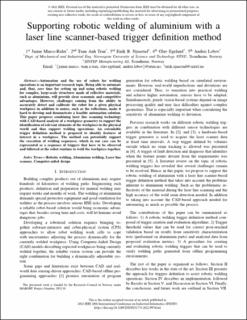| dc.contributor.author | Marco Rider, Jaime | |
| dc.contributor.author | Tran, Tuan Anh | |
| dc.contributor.author | Njåstad, Eirik | |
| dc.contributor.author | Egeland, Olav | |
| dc.contributor.author | Lobov, Andrei | |
| dc.date.accessioned | 2023-03-01T15:46:27Z | |
| dc.date.available | 2023-03-01T15:46:27Z | |
| dc.date.created | 2022-12-16T14:39:02Z | |
| dc.date.issued | 2022 | |
| dc.identifier.citation | 2022 IEEE 20th International Conference on Industrial Informatics (INDIN). 2022, 399-406. | en_US |
| dc.identifier.isbn | 978-1-7281-7568-3 | |
| dc.identifier.uri | https://hdl.handle.net/11250/3055113 | |
| dc.description.abstract | Automation and the use of robots for welding operations is an important research topic. Being able to automate and, thus, save time for setting up and using robotic welding for complex, large-scale structures made of reflective materials, such as aluminium, will provide clear economic and competitive advantages. However, challenges coming from the ability to accurately detect and calibrate the robot for a given physical workpiece in addition to noises, such as the reflections, make it hard to develop and demonstrate a feasible automation solution. This paper proposes combining laser line scanning technology with CAD-based analysis of a workpiece geometry to support the identification of relevant elements of the workpiece in the physical world and thus support welding operations. An extendable trigger definition method is proposed to identify features of interest in a workpiece. The method can potentially support the execution of welding sequences, which in our case can be represented as a sequence of triggers that have to be observed and followed at the robot runtime to weld the workpiece together. | en_US |
| dc.language.iso | eng | en_US |
| dc.publisher | IEEE | en_US |
| dc.relation.ispartof | The 20th IEEE International Conference on Industrial Informatics (INDIN) | |
| dc.title | Supporting robotic welding of aluminium with a laser line scanner-based trigger definition method | en_US |
| dc.title.alternative | Supporting robotic welding of aluminium with a laser line scanner-based trigger definition method | en_US |
| dc.type | Chapter | en_US |
| dc.description.version | acceptedVersion | en_US |
| dc.subject.nsi | VDP::Teknisk kybernetikk: 553 | en_US |
| dc.subject.nsi | VDP::Technical cybernetics: 553 | en_US |
| dc.subject.nsi | VDP::Teknisk kybernetikk: 553 | en_US |
| dc.subject.nsi | VDP::Technical cybernetics: 553 | en_US |
| dc.source.pagenumber | 399-406 | en_US |
| dc.identifier.cristin | 2094489 | |
| dc.relation.project | Norges forskningsråd: 295138 | en_US |
| cristin.ispublished | true | |
| cristin.fulltext | postprint | |
